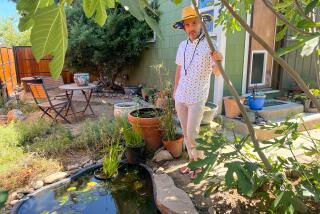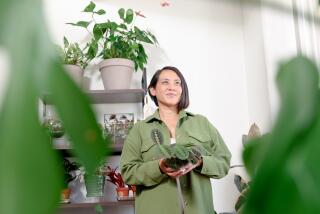How to keep your houseplants alive. (Hint: Don’t love them to death)
We’ve all seen it happen: A plant that looked so lush and lovely in the store curls up and dies once it enters your home.
Maybe this fear makes you wary, or you’ve committed enough houseplant homicide that you never want to try again, let alone give one to your mom as a gift on this Mother’s Day. But here’s the truth: Houseplants don’t have to be hard.
Most problems fall into two categories: benign neglect or death by kindness, say houseplant specialists Annette Goliti Gutierrez, co-owner of Potted, an Atwater Village store devoted to houseplants and pots, and Jessica Lawrence, a horticulturist and indoor plant care instructor at Fig Earth Supply in Mount Washington.
The biggest problem with benign neglecters is they forget — or maybe never knew — that houseplants require consistent water, light and a little love to thrive, said Gutierrez.
Air plants, for instance, are colorful and popular because they can live in a dish without any soil, “but I wish I had a dollar for every time people ask, ‘So we don’t have to water these, right?’ ” Gutierrez said. “And I have to say, ‘Well, no, like all living things, even air plants have to be watered.’ ”
(Sound familiar? Check out these easy tips in Sunset for keeping air plants alive.)
More often than not, though, houseplants die because they’re being loved to death, according to Lawrence and Gutierrez. The biggest culprits? Improper planting, overwatering and the wrong kind of light.
Keeping them alive isn’t hard, they say, if you follow the simple instructions below:
Don’t be too quick to move them
Most houseplants were raised in a greenhouse, then wrenched out of their perfect environment to sit in a store until you came along, Lawrence said, “so when you bring them home, they’re stressed out, like a baby who’s been yanked from the womb.”
Transplanting into your new decorative pot will just stress them out more and make it harder to give them the care they need. The solution: Keep your houseplants in their plastic nursery pots for at least the first year.
You can still use your pretty pot, Lawrence and Gutierrez say. Just slip the new plant, plastic pot and all, into the decorative pot and cover the top with Spanish moss or rocks to cover any gaps.
The nursery pots have excellent drainage, unlike a lot of decorative pots. And when you water, you can easily move the plant to the sink or tub, give it a good dousing and then let it drain before putting it back, eliminating the need for drainage saucers (which look pretty tacky under your decorative pots anyway).
Most houseplants grow slowly and like to fit tight in their pots, Lawrence said, but when the pot is more roots than soil, it’s time to transplant. At that point, just go up one, or at most two, pot sizes. “The size of the pot doesn’t make the plant grow faster, and with all that extra soil it makes it harder for the roots to get the water and nutrients they need.”
Final note: When you transplant, add potting soil (not garden soil) to the bottom of the pot to get the plant up to the height you want. Never put the plant in the bottom of the pot and cover it with soil because that can suffocate the plant.
Water, don’t drown
Improper watering is the most common cause of plant fatalities, Lawrence and Gutierrez said, usually because well-intentioned people end up drowning their plants.
When Lawrence had a business caring for indoor office plants, she couldn’t understand why so many kept dying until she discovered that employees kept emptying their leftover coffee or bottled water into the soil every day.
They thought they were helping, she said, but instead the plants were suffocating in standing water or rotting from perpetually soggy roots.
This is a serious problem for people who water on a schedule every week, never noticing whether their plants are wet or dry.
“Instead of putting your plants on a watering schedule, I tell people to put them on a checking schedule,” Lawrence said, “because not all plants need to be watered at the same time.”
Stick your finger a good inch or two into the soil to see if it’s dry before you decide to add water. If you don’t trust your finger, buy an inexpensive moisture tester (such as Amazon’s $12 moisture-pH-light meter).
Sometimes plant owners are just plain stingy, moistening the top of the soil but never getting water to the roots. The plant is basically parched, Gutierrez said, and the salt and minerals in our water tend to accumulate unhealthily in the soil.
So when it’s time to water, take the plant to the sink or bathtub (preferably in its original nursery pot) and give it a good soak, so the water flushes out any impurities and the root ball gets thoroughly wet.
If the soil is really dry, it can actually repel water, Lawrence said, like a new sponge that won’t absorb moisture until it’s immersed. Sitting the plant in a few inches of water for 20 or 30 minutes will help it draw in moisture at the roots, where it’s needed most.
Let there be light
News flash: Indoor plants need light to thrive, but “unless it’s a cactus you’re growing indoors, you don’t want a plant near a window with bright hot sun,” Lawrence said.
Seek out indirect light from north-facing or east-facing windows, and keep plants far away from the harsh, hot rays from the south and west, which are only magnified as they come through the glass.
Avoid sticking your plants in corners or under stairwells, however, where they get little or no natural light. Plants need some kind of consistent light to perform photosynthesis and get the energy they need to thrive.
“There are some dark-leaf plants that can tolerate low light, but they’re never going to flower or get big,” said Gutierrez, whose houseplant care tips are available online. If you must put a plant in a dark area, install a little grow light, or even an LED light above it, that comes on regularly for at least eight hours a day, she said.
A timer is helpful, but Gutierrez remembers being astonished by a trailing pothos plant that was flourishing in a windowless doctor’s office.
“Then I realized the lights were on from the second people walked in the building until they left at night, so that plant was getting enough light to perform photosynthesis,” she said. “Not all plants will respond that well, but for it to work, you’ve got to keep that light on consistently, so you’re mimicking daylight.”
More to Read
Sign up for The Wild
We’ll help you find the best places to hike, bike and run, as well as the perfect silent spots for meditation and yoga.
You may occasionally receive promotional content from the Los Angeles Times.











